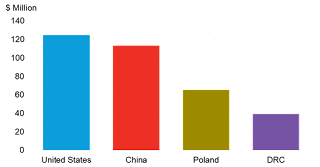Africa should lead in green Industrialization
 |
| A Lithium-ion Battery |
Lithium-ion batteries power everything from your Mobile
phone to Airplane batteries. Now that the world is shifting to clean energy to
power cars, Lithium-Ion is also powering electric vehicles, EVs. The Democratic
Republic of Congo produces 70 percent of the world's cobalt, the basic Mineral in
Lithium-ion batteries.
Cathode precursor materials are the intermediate material
between cobalt and finished cathode material. Currently, precursor materials
are produced in China from the cobalt imported from D R Congo. Poland produces cathode
materials and cells, and Germany the final pack assembly.
Now D R Congo plans to upgrade its role from mining to
processing to increase its stake in the BEV industry. This beneficiation could
increase the country’s export earnings by US$54 billion a year, says Vera
Songwe, the United Nations Economic Commission for Africa's
head. “If the DRC captures 20 percent of the market
share for battery production, it will add around US$54 billion to its income
and raise its GDP tremendously,” she said.
The odds are DR Congo’s favor according to a new study. The study,
by BloombergNEF, shows that building a 10,000 metric-ton battery precursor plant
in the DRC would cost $39 million. A similar plant in the US, China, and Poland
would cost an estimated US$ 120 million, $112 million, and $65 million,
respectively. This is due to its “relatively
cheap access to land and low engineering, procurement and construction, or EPC cost compared to the U.S., Poland, and China,” said Kwasi Ampofo, lead author of
the report.
Nothing stops D R Congo from expanding its role in Battery
Electric manufacturing. It can carry out the processes performed in Poland and
Germany. In fact, the creation of a Special Economic Zone could end up onshoring
all the BEV manufacturing in D R Congo in particular, and Africa in general,
with DRC as the nerve center.
Proximity to the raw materials and its reliance on
hydroelectric power plants would lower the environmental footprint. In fact, says
the report, it will lower emissions associated with Lithium-ion battery
production by 30 percent.
The battery precursor
segment is worth US$271 billion. However, the combined battery cell production
and cell assembly segments of the battery minerals global value chain are worth
a mouthwatering US$1.4 trillion.
DRC’S President Felix Tshisekedi hinted at the intention to
go big by urging his African counterparts to prioritize joint investments aimed
at increasing Africa’s share of the BEV and renewable energy value chain.
Experts at the forum echoed the President, urging Africa to
exploit AfCTA, the continental Free Trade area, to onshore other processes and
increase their share in the BEV market. The
DRC can receive other upstream mineral inputs needed for lithium-ion batteries
– such as manganese from, say, South Africa and Madagascar, copper from Zambia,
graphite from Mozambique and Tanzania, phosphate from Morocco, and lithium from
Zimbabwe, to name but a few,” say experts.
The battery and electric vehicles (BEV) value chain will be
worth US$ 8.8 trillion in 2025, rising US$46 trillion by 2050, says the
BloombergNEF report titled “The Cost of Producing Battery Precursors in
the DRC.”
The market for BEV manufacturing is wide-open, say experts.
Although there are notable leading electric-vehicle and cell manufacturers
today, the sheer scale of growth expected in the long-term throws open the
doors for competition and dominance of the new value chain. African countries
could play a major role in the lithium-ion battery supply chain by taking
advantage of their abundant natural resources and onshoring more of the value
chain.
Africa is not sitting on its laurels, Markus Thill, the vice president of the African
Association of Automotive Manufacturers (AAAM), announced at the forum that,
“AAAM is working with AfCFTA Secretariat to produce at least 5 million vehicles
in Africa for Africa by 2025.”Thill is also the President of Bosch Africa.
 |
| Capital Costs compared: Congo beats hands down |
However, the continent must move swiftly. “We are only at
the beginning of the path to achieving net-zero emissions globally. Emerging
economies in Africa can gain significant long-term economic value by quickly
setting up projects that support the low-carbon transition with transparent
governance frameworks,” stated Ashish Sethia, global head of commodities at
BNEF.



Comments
Post a Comment